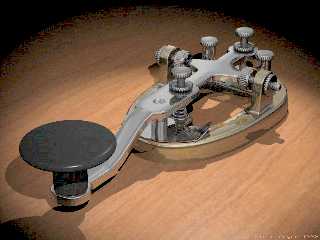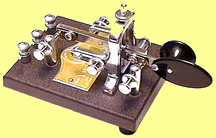K0WA's CW Page
Morse Code is easy to learn...really!
|
Morse code is fun! It will continue to be part of Ham radio for years to come as well. The military and government services might have abandon Morse code, but amateurs will always have a soft spot for the mode. I know that more and more newcomers are getting into the mode as well. Really! I started out hating Morse. I did not want to learn it. But I was super excited about being a Ham. So, I struggled through and learned the code. I was 14 years old at the time. Now, Mom and Dad and little money to spend on my hobby, so I was stuck. As a Novice I could only run CW on 80, 40 and 15 meters, but I could operate phone on 2-meters. Yep, 2-meters. The Newton Amatuer Radio Club had a pile of Heathkit Twoers and all the Novices had them. A Twoer had 5 watts on AM. But, I was in love with HF and working great distances...meaning Emporia about 60 miles away. Well, I struggled with the code but finally got my General ticket. I thought I was done with CW.
But, I was always drawn back to CW as well. I got into the National Traffice System and was checking into QKS, the Kansas CW net. Soon, I got to be net control and was doing liasion work between Tenth Region Net and Central Area Net. This was the time I fell in love with Morse code. I would spend the whole evening on the radio passing traffic. Although I had done a lot of traffic handling in high school, I left that to others as I chased my lot in life. I first chased girls for awhile and then I chased after school work attending Kansas State University. I had won the girl chase and married Ruby, my lovely wife of 32 years. While I was at KSU, I was introduced to contesting. My wife said I was never the same. I really fell for CW contesting. Bruce, K0BJ (WA0TAS), got me started in Sweepstakes in 1972. I love CW contesting. There is nothing like working 80, 90 or 120 QSOs and hour on CW when the band is hot and I have a hot hand. CW - The First Digital Protocol I really enjoy using the first digital communication protocol. Yes, Morse code is a digital communication protocol which is based on timing, much like Ethernet and TCP/IP. What is different about the Morse code protocol is that you don't need to use a computer or a modem to connect. Your modem and computer are all self contained in your head. Morse code protocol was developed to be used on a small compact computer platform called "The Brain!" I/O is a simple ear and digital fingers. "The Brain" was the first computer ever devised and is a pretty quick device. It is a multi-tasking CPU and can handle a lot of I/O. For Morse Code, it is ideal. Here is how it works: The Ear Port (EPT-Left and EPT right) receives the input where it is buffered for a very brief time by a very fast biological computer. The information is decoded into a language of choice (ie.; Japanese 42 characters, Crylic - 36 characters, or English - 26 characters + punctuation) and then either placed in memory or outputed to the Finger Port (FPT-Left or FPT-Right). The output to the FTP ports is a dual output port and can be used for hard copy (printed output) or interfacing with a non-biological instrument to generate the Morse code protocol. These non-biological devices could be a simple switch that makes or breaks, or a complex electronic digital device that augments the output of the FPT port to increase throughput. Generally, input speed is faster than output speed so users have had to learn how to buffer the protocol for hard copy.
A lot of people are complaining these days about learning the Morse Code. Why? What is the purpose of such an arcane protocol. Well, the answer is not simple. For me, I love the mental challenge and the tremendous feeling of satisfaction that I have mastered something as Morse Code. For me, Morse Code was hard to learn, but once it was firmly loaded into my memory I became enthralled by its beauty. It took work...hard work, but I did it. On a good day, I can copy 40 to 45 words per minute. My comfortable speed is around 30 words per minute. But, a standard speed is around 18 words per minute. What is going to happen to Morse Code in amateur radio? No one really knows right now, but it will be around for some time. I'm sure it will go away, but as long as I have someone to talk to, you'll find me on the bottom end of any amateur radio band in the CW portion of the band. (By the way, I like other modes of communication as well.) |
| A .-
di-dah B -... dah-di-di-dit C -.-. dah-di-dah-dit D -.. dah-di-dit E . dit F ..-. di-di-dah-dit G --. dah-dah-dit H .... di-di-di-dit I .. di-dit J .--- di-dah-dah-dah K -.- dah-di-dah L .-.. di-dah-di-dit M -- dah-dah N -. dah-dit O --- dah-dah-dah P .--. di-dah-dah-dit Q --.- dah-dah-di-dah R .-. di-dah-dit S ... di-di-dit T - dah U ..- di-di-dah V ...- di-di-di-dah W .-- di-dah-dah X -..- dah-di-di-dah Y -.-- dah-di-dah-dah Z --.. dah-dah-di-dit NUMBERS 1 .----
di-dah-dah-dah-dah ( -.--.
dah-di-dah-dah-dit Full
Stop .-.-.- di-dah-di-dah-di-dah [AAA] |
Here is a hint. Learn the sound, not the code.
 Well that
is not what happened. Mom and Dan had no money for a SSB rig and I was
unemployed. Heck, I was just a kid out of Junior High. So, I scraped
together enough money to buy an old Heathkit DX-40 and a VF-1. I had
a NC57 receiver that I had purchased from a guy at church for $25. Ten
meters was very hot in 1968 and I spent a lot of time running 40 watts
AM phone on 10 meters.
Well that
is not what happened. Mom and Dan had no money for a SSB rig and I was
unemployed. Heck, I was just a kid out of Junior High. So, I scraped
together enough money to buy an old Heathkit DX-40 and a VF-1. I had
a NC57 receiver that I had purchased from a guy at church for $25. Ten
meters was very hot in 1968 and I spent a lot of time running 40 watts
AM phone on 10 meters.  The problem
is related to the FPT port not working as fast as the EPT ports. Many
people use different methods to increase the FTP ports such as using
wordprocessors or large memory buffers.
The problem
is related to the FPT port not working as fast as the EPT ports. Many
people use different methods to increase the FTP ports such as using
wordprocessors or large memory buffers.